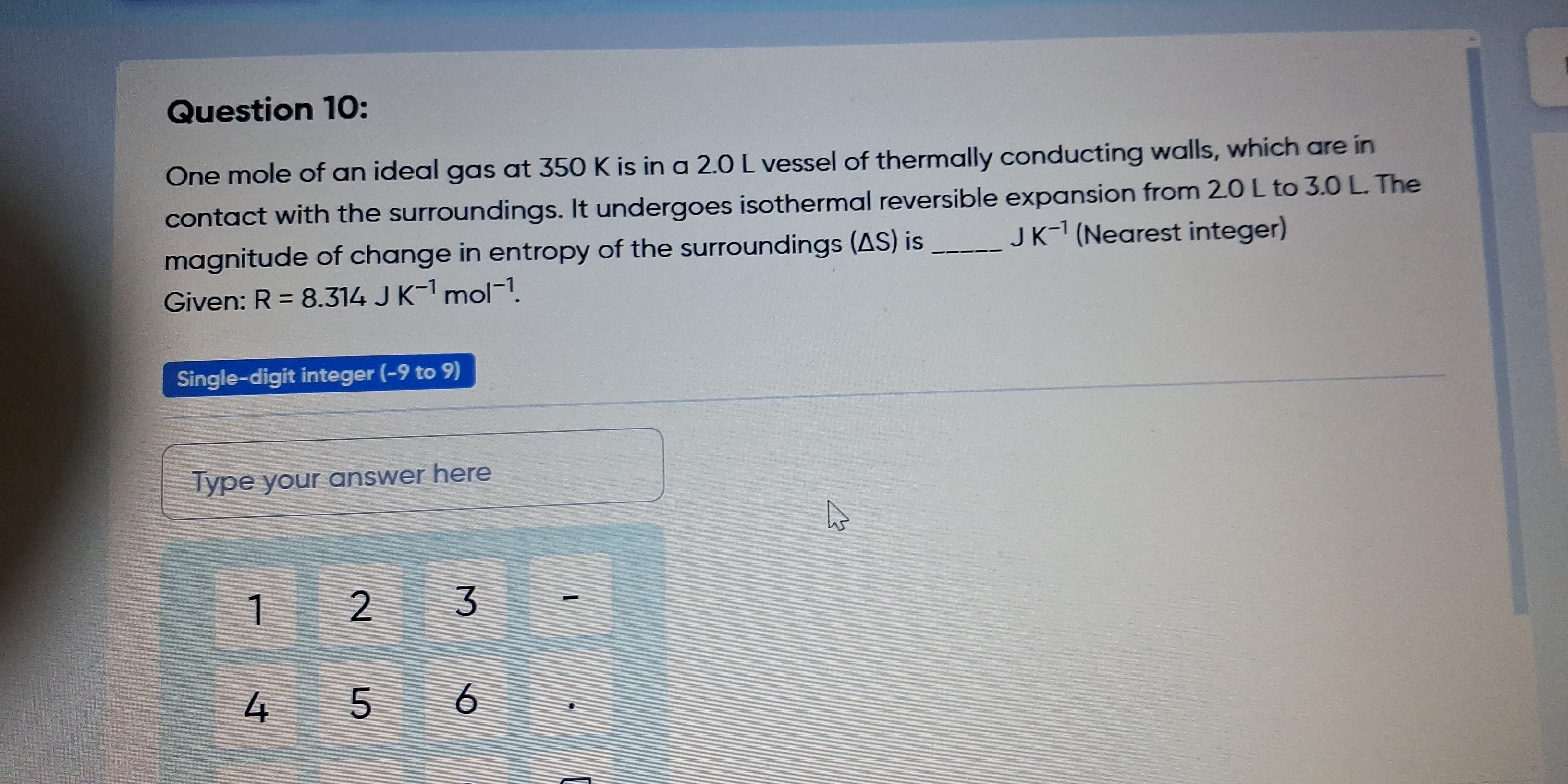One mole of an ideal gas at 350 K is in a 2.0 L vessel of thermally conducting walls, which are in contact with the surroundings. It undergoes isothermal reversible expansion from... One mole of an ideal gas at 350 K is in a 2.0 L vessel of thermally conducting walls, which are in contact with the surroundings. It undergoes isothermal reversible expansion from 2.0 L to 3.0 L. The magnitude of change in entropy of the surroundings (ΔS) is _____ J K⁻¹ (Nearest integer). Given: R = 8.314 J K⁻¹ mol⁻¹.

Understand the Problem
The question is asking for the change in entropy ( \Delta S ) of the surroundings due to the isothermal reversible expansion of one mole of an ideal gas when the volume changes from 2.0 L to 3.0 L at a constant temperature of 350 K. Given the value of the gas constant (R), we will apply the formula for entropy change in isothermal processes to compute the answer.
Answer
The magnitude of the change in entropy of the surroundings is $2 \text{ J K}^{-1}$.
Answer for screen readers
The magnitude of the change in entropy of the surroundings ($\Delta S$) is approximately $-2 \text{ J K}^{-1}$.
Steps to Solve
- Identify the entropy change formula
For isothermal reversible processes, the change in entropy ($\Delta S$) of the surroundings can be calculated using the formula: $$ \Delta S_{\text{surroundings}} = -\frac{Q_{\text{rev}}}{T} $$
- Calculate the work done
For isothermal expansion of an ideal gas, the heat absorbed by the gas ($Q_{\text{rev}}$) is equal to the work done by the gas during expansion. This can be calculated using: $$ Q_{\text{rev}} = nRT \ln\left(\frac{V_f}{V_i}\right) $$ Where:
- $n = 1 \text{ mol}$
- $R = 8.314 \text{ J K}^{-1} \text{ mol}^{-1}$
- $T = 350 \text{ K}$
- $V_i = 2.0 \text{ L}$
- $V_f = 3.0 \text{ L}$
- Insert values into the entropy formula
Calculate $Q_{\text{rev}}$: $$ Q_{\text{rev}} = 1 \cdot 8.314 \cdot 350 \ln\left(\frac{3.0}{2.0}\right) $$
- Evaluate the natural logarithm
Calculate $\ln\left(\frac{3.0}{2.0}\right)$: $$ \ln\left(\frac{3.0}{2.0}\right) \approx 0.4055 $$
- Compute $Q_{\text{rev}}$
Now plug the value back into the formula for $Q_{\text{rev}}$: $$ Q_{\text{rev}} = 1 \cdot 8.314 \cdot 350 \cdot 0.4055 $$
- Calculate the entropy change
Finally, substitute $Q_{\text{rev}}$ into the entropy change formula: $$ \Delta S_{\text{surroundings}} = -\frac{Q_{\text{rev}}}{350} $$
- Final calculations
Complete the calculations to find the exact value of $\Delta S_{\text{surroundings}}$.
The magnitude of the change in entropy of the surroundings ($\Delta S$) is approximately $-2 \text{ J K}^{-1}$.
More Information
In an isothermal expansion, heat is absorbed by the system (the gas), resulting in a decrease in the entropy of the surroundings. The negative sign indicates that entropy has decreased in the surroundings due to heat transfer to the gas.
Tips
- Not using the correct values for $V_i$ and $V_f$ in the logarithm calculation.
- Forgetting to convert the logarithm from base $e$ to base 10 if needed, but in scientific contexts, using natural logarithm is standard.
- Confusing the sign of the entropy change for the surroundings; it should be negative due to the heat absorbed by the gas.
AI-generated content may contain errors. Please verify critical information